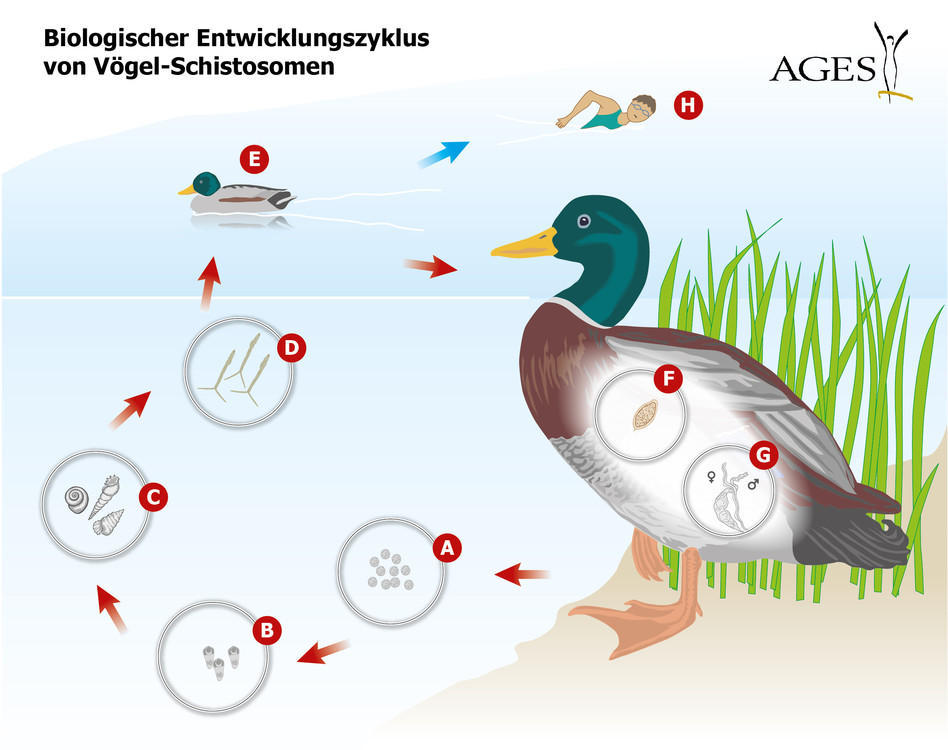Bathing water monitoring
In Austria, there are 260 bathing sites defined as "EU bathing waters". This means that the quality of their water is regularly examined according to uniform criteria throughout Europe. This applies, for example, to certain indicator germs that indicate possible contamination with fecal matter, but also to visibility depth and temperature. With the official start of the bathing season on June 15, our bathing water database and bathing water app provide information and current readings on water quality, visibility depth and temperature of all Austrian bathing sites. You can download the app here. The bathing water database is created in cooperation with and on behalf of the Federal Ministry of Social Affairs, Health, Care and Consumer Protection.
Bad Mitterndorf - Ödensee, Kainisch
Bezirkshauptmannschaft Liezen
8940 - Liezen, Hauptplatz 12
Telefon: +43 3612 28010
E-Mail:
Weitere Informationen
Gute Badegewässerqualität
Mangelhafte Badegewässerqualität
Baden verboten / vom Baden wird abgeraten
Jahresübersicht
2021![]()
2022![]()
2023![]()
2024![]()
![]() Einstufung nach der EU-Richtlinie 2006/7/EG
Einstufung nach der EU-Richtlinie 2006/7/EG
![]() Ausgezeichnete Badegewässerqualität
Ausgezeichnete Badegewässerqualität
![]() Gute Badegewässerqualität
Gute Badegewässerqualität
![]() Ausreichende Badegewässerqualität
Ausreichende Badegewässerqualität
![]() Mangelhafte Badegewässerqualität
Mangelhafte Badegewässerqualität
![]() Die Badestelle wurde von der EU noch nicht abschließend bewertet
Die Badestelle wurde von der EU noch nicht abschließend bewertet
![]() Das Badegewässer erhält aufgrund umfangreicher Sanierungsmaßnahmen die Klassifikation "Changes" bis ein ausreichend großer Datensatz für eine neue Einstufung vorliegt
Das Badegewässer erhält aufgrund umfangreicher Sanierungsmaßnahmen die Klassifikation "Changes" bis ein ausreichend großer Datensatz für eine neue Einstufung vorliegt
![]() Baden verboten / vom Baden wird abgeraten
Baden verboten / vom Baden wird abgeraten
Lage des Badegewässers
Every year, the European Commission publishes a report on the quality of bathing water, which is issued before the start of the next bathing season. In the 2024 report, 249 (95.8%) of the 260 Austrian bathing sites were rated as "excellent", 7 bathing sites as "good", two bathing sites as "sufficient" and one site as "poor".
Indicator germs that indicate possible contamination with faeces
Escherichia coli The guideline value of 100 CFU/100 ml should not be exceeded. If a limit value of 1000 CFU/100 ml is exceeded, a follow-up control must be carried out as soon as possible. If the limit value is also exceeded, the district administrative authority must be informed.
Intestinal enterococci The guideline value of 100 CFU/100 ml should not be exceeded. If the limit value of 400 CFU/100 ml is exceeded, a follow-up control must be carried out as soon as possible. If the limit value is also exceeded, the district administrative authority must be informed.
Water transparency
As a rule of thumb, you should be able to see your feet when you are standing in water up to your knees. The water samples are taken 20 to 30 cm below the water surface. At the same time, a site report is made, recording, among other things, the weather, the number of bathers, or the presence of waterfowl. The samples are brought to the laboratory cooled and protected from light, where they must be incubated for 36-72 hours before being analyzed. The result of the analysis is thus available up to three days after sampling.
Bath dermatitis
Higher water temperatures are not only pleasant for humans, water snails can also reproduce better in them - and in the water snails also cercariae, microscopic parasites that can lead to itching and rashes in humans, to so-called bath dermatitis.
Cercariae (fork-tailed larvae) are larvae of sucking worms. They develop in aquatic snails and are subsequently excreted in large quantities. They are found in both freshwater and saltwater, mainly in shallow shorelines. In water, they survive only one day, so they must enter waterfowl quickly to complete their development cycle. Humans are only "unintentionally" infested; the parasites die quickly in the skin. However, they can trigger an immune reaction that leads to itching and skin rashes, bath dermatitis.
The initial infection is often asymptomatic (= without signs of illness) and remains undetected. If symptoms occur, they are usually mild and quickly subside. However, if a person is infected several times by cercariae, itching, redness and wheals may occur, some of them severe. In most cases, bath dermatitis subsides after one to two weeks at the most.
The presence of cercariae does not mean that the water quality is poor. Suitable water snails must be present for the formation of cercariae to occur at all. In Austria, the occurrence of bath dermatitis was first described in the late 1960s; since then, cercariae associated with cases of bath dermatitis have been documented in individual water bodies in all provinces. Chlorinated water, e.g., in a public swimming pool or outdoor pool, does not pose a risk for bathing dermatitis.
Water birds infected by avian schistosomes (= sucking worms) release worm eggs (A) into the water via their feces. The hatched larvae of the first generation, called miracidia (B), infest water snails (C) as intermediate hosts. The third generation of larvae - the cercariae (D) - are released into the water by the water snails (sometimes other intermediate hosts are also required), especially at temperatures above 24°C. These larvae then seek out a duck bird (E) as the final host and penetrate its skin in the water. The cercariae lose their tail structures and become schistosomulae (F), which enter the intestine via the portal tract, where they become sexually mature, approximately 10 mm long sucker worms (G). The eggs of these worms, also known as couch flukes, then re-enter the water with the duck droppings. The skin of bathing humans (H) is only pierced by mistake; in human skin, cercariae die within hours.
Cyanobacteria ("algae bloom")
When it's hot, cooling down does you good. But caution is needed in some ponds, pools, etc: High water temperatures and nutrient levels can cause a rapid proliferation of cyanobacteria, the so-called "algal bloom." Cyanobacteria, colloquially called "blue-green algae," are not true algae, but bacteria and natural components of surface waters.
Signs of cyanobacteria in the water are:
- bluish-green turbidity of the water
- streaking
- "algae carpets" on the water surface ("pea soup")
- limited visibility depth of less than 1 meter
Cyanobacteria can produce toxins (poisons) that can be fatal to dogs, such as when they lick patches of algae from their fur or eat the rotting algal material on the shore.If large amounts of water are swallowed by humans or enter the respiratory tract, nausea, fever, vomiting, diarrhea, skin rashes, collapse, or paralysis may occur. Absorption of cyanotoxins through the skin is unlikely, but skin irritation, inflammation, or allergic reactions may occur. More serious health consequences represent gastrointestinal inflammation, respiratory diseases and liver damage.
The EU bathing waters are regularly checked hygienically and, in case of suspicion, also tested for cyanotoxins. However, smaller bathing lakes and swimming ponds are not always sampled. If a water body is suspected of showing an accumulation of cyanobacteria, water samples can be tested for cyanotoxins by us at a charge.
WHO cyanotoxin guideline values:
- Microcystins: 24 μg/L
- Cylindrospermopsins: 6 μg/L
- Anatoxins: 60 μg/L
- Saxitoxins: 30 μg/L
Tips:
- Do not bathe if you cannot see your feet because of a greenish-bluish haze
- Beware of water sports where a lot of water can be swallowed
- Shower and clean your swimwear
- Also watch out for your children and pets
Our products & services for water hygiene
Last updated: 11.07.2025
automatically translated

 14.6 °C
14.6 °C 2.00 m
2.00 m